iPhone Slump In China Sinks Apple's First Quarter

When Apple (NASDAQ:AAPL) reported the results of its fiscal 2018 fourth quarter, the company knew that it would face tough comps for the upcoming first quarter, and its forecast reflected that reality. Apple guided for revenue in a range of $89 billion to $93 billion, representing year-over-year growth of just 0.8% to 5.3%.
Unfortunately, some of the emerging market growth that Apple was banking on didn't come to pass, and in a letter to investors on Jan. 2, Apple CEO Tim Cook said the company is now lowering its revenue guidance to approximately $84 billion, or a decline of nearly 5% compared to the prior-year quarter.
This article originally appeared in the Motley Fool.
Let's take a look at what else Cook said and what it means for shareholders.
Plenty of challenges...
The timing of the iPhone launch that occurred in the first quarter of fiscal 2018, set the stage for difficult year-over-year comparisons, as the iPhone XS and iPhone XS Max shipped in the fiscal 2018 fourth quarter.
Apple's original forecast also accounted for the strong U.S. dollar being a headwind and negatively impacting results. That occurred much as the company predicted.
But the biggest hit seems to be the result of economic weakness in certain emerging markets. The company had built this into its forecasts but failed to anticipate, as Cook said, "the magnitude of the economic deceleration," singling out Greater China as the biggest culprit. Cook said that the GDP growth reported by the Chinese government was the second-worst in the past 25 years and that the economic situation was further impacted by the ongoing trade war with the U.S.
...but it all came down to the iPhone
A shortfall in iPhone revenue, primarily in Greater China, will ultimately account for most of Apple's revenue shortfall and the predicted year-over-year revenue decline. As evidence, non-iPhone revenue is expected to grow nearly 19% year-over-year thanks to success in the services, Mac, and wearables segments.
China wasn't the only contributor, as iPhone upgrades overall have not been as strong as Apple expected them to be. Apple has blamed the shortfall on macroeconomic challenges, fewer carrier subsidies, the strength of the dollar, and customers taking advantage of lower-cost battery replacements before the option expired.
Positive spin
In his letter, Cook was optimistic, trying to put a positive spin on the quarter that just ended. He noted that Apple's installed base of devices grew by more than 100 million units over the previous 12 months. You may recall that the company reported an installed base of 1.3 billion devices in the first quarter of fiscal 2018, which would suggest that number has since grown to 1.4 billion.
Cook also said that Apple achieved all-time record revenue in the fiscal first quarter of 2019 from services, wearables, and Mac sales. Services generated $10.8 billion during the quarter, hitting a new quarterly record in all the company's geographic segments. Wearables grew by nearly 50% year over year, driven by the holiday popularity of Apple Watch and AirPods.
While the picture doesn't look great, these are preliminary results only, and Apple will have much more to say on the matter when the company reports its full results on Tuesday, Jan. 29.
Danny Vena owns shares of Apple. The Motley Fool owns shares of and recommends Apple. The Motley Fool has the following options: long January 2020 $150 calls on Apple and short January 2020 $155 calls on Apple. The Motley Fool has a disclosure policy.




















